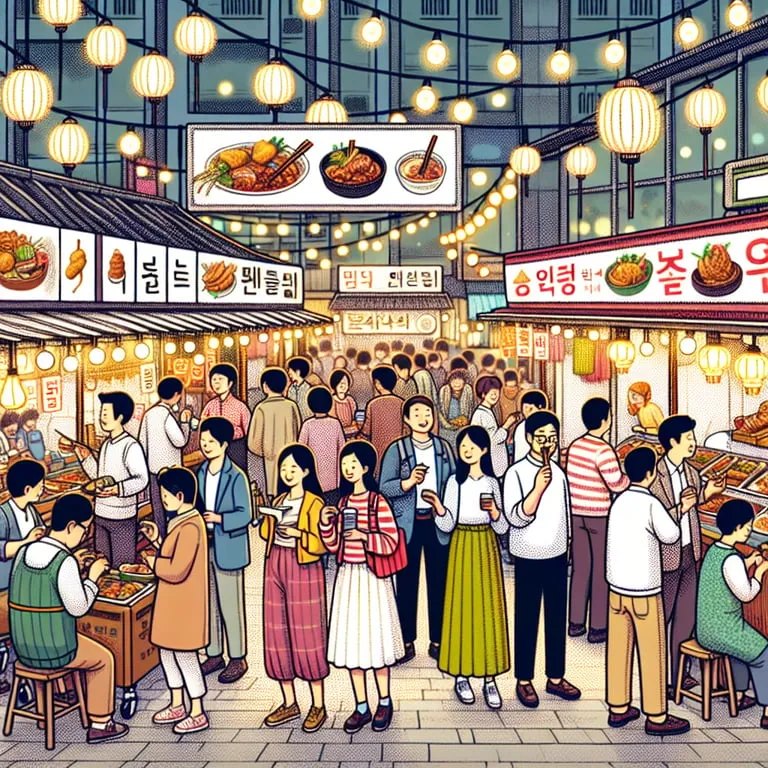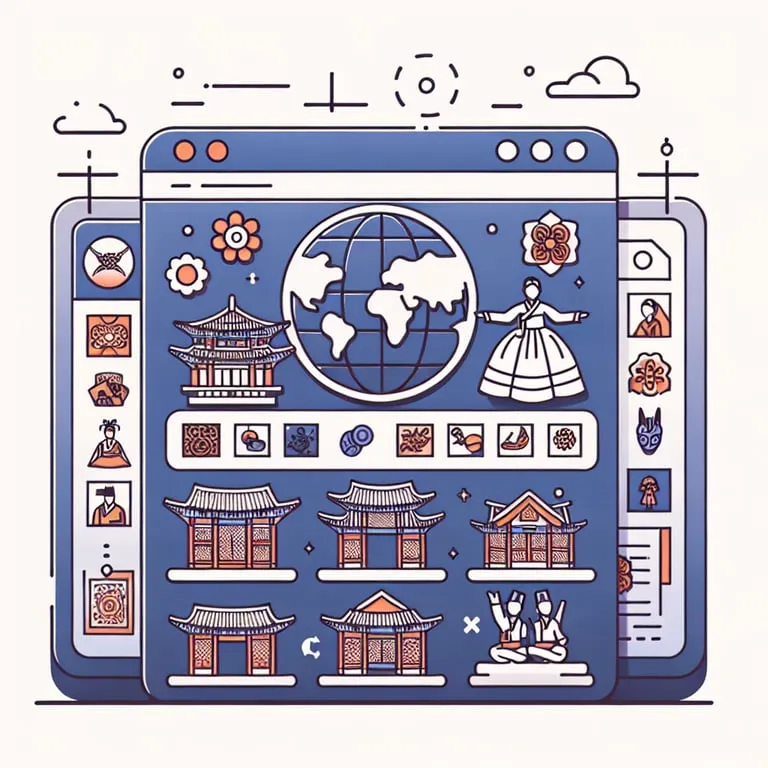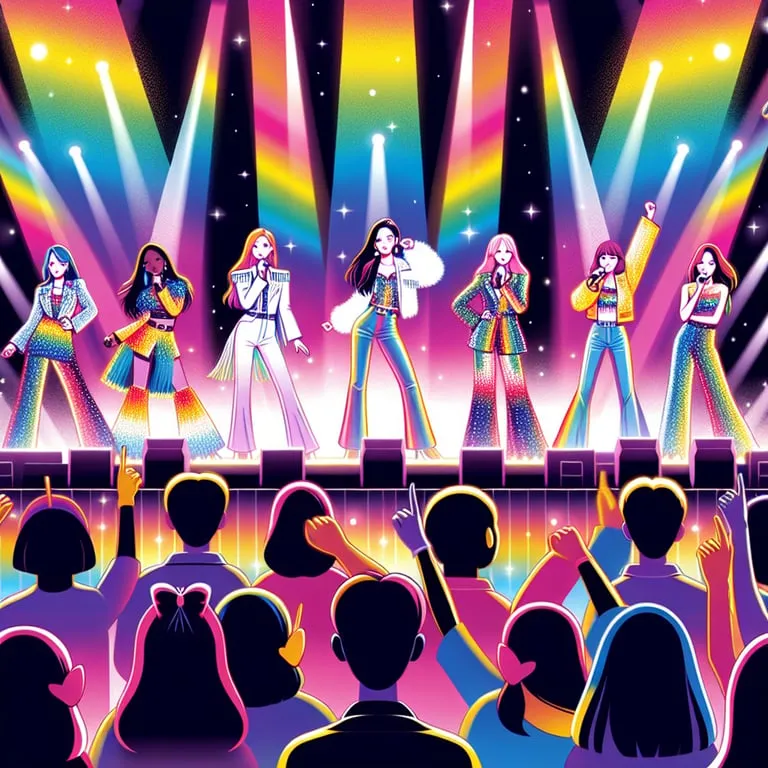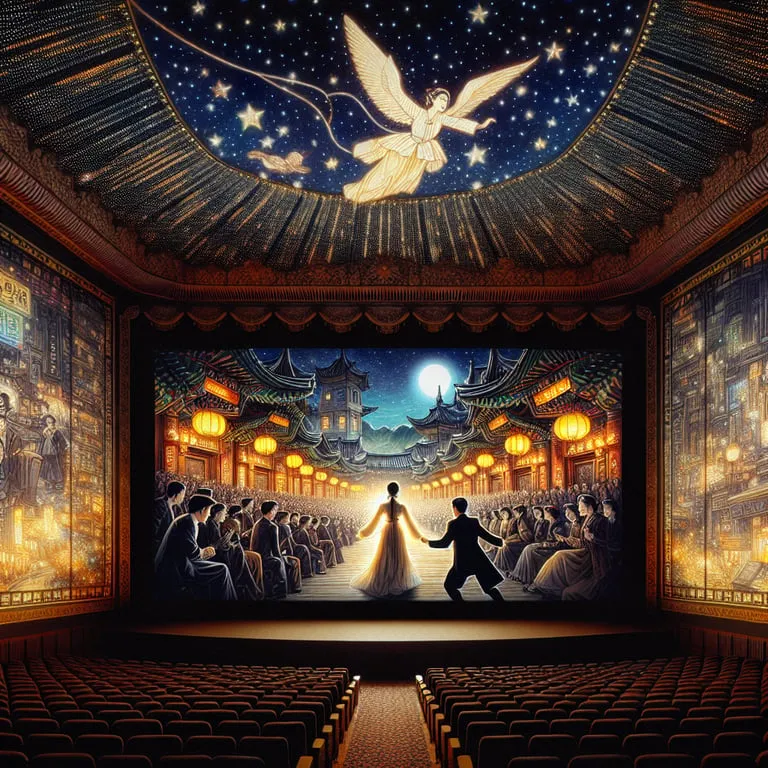Korean street food offers a sensory feast, combining traditional flavors with modern culinary twists. This vibrant scene attracts food enthusiasts worldwide, eager to taste its unique offerings. From sizzling savory dishes to delectable sweet treats, these delicacies provide an authentic cultural experience. Exploring these street markets requires a nuanced approach, ensuring you savor the best bites while navigating the bustling alleys. Dive into this culinary journey with our expert guide to uncover Korea’s must-try street food delights. Experience the rich tapestry of flavors that Korean street food is celebrated for, ensuring a memorable gastronomic adventure.

Exploring the Vibrant Street Food Scene
The street food scene in South Korea is nothing short of a gastronomic symphony, a vibrant tapestry woven with vivid flavors and culinary wonders that captivate the senses. With its roots tracing back to the Joseon Dynasty, street food culture has evolved into a modern-day phenomenon, garnering global attention and culinary acclaim. According to data from the Korea Tourism Organization, over 20 million foreign visitors in 2019 alone made tasting Korea’s street food a priority during their stay, highlighting its undeniable allure.
The Bustling Streets of South Korea
Let’s delve into the bustling streets of Seoul, Busan, and other dynamic cities where street food vendors line the alleyways, offering an incredible range of treats that can satisfy even the most sophisticated palate. From the buzzing Gwangjang Market, which boasts over 100 food stalls, to the celebrated paths of Myeong-dong, famous for its diverse offering, Korea’s street food scene is as diverse as it is delicious.
Tradition Meets Innovation
A hallmark of Korean street food is its ability to juxtapose tradition with innovation. Picture this: vendors serving up Tteokbokki, a spicy rice cake dish drowning in a fiery gochujang sauce that tantalizes the taste buds, or Hotteok, a popular sweet Korean pancake filled with melted brown sugar, honey, and nuts. These classic dishes are often crafted using traditional methods passed down through generations, ensuring that every bite resonates with authentic flavors.
Statistics indicate that the South Korean street food industry generates a revenue of approximately 3.5 trillion KRW annually, underscoring its significance in the culinary and cultural landscape of the nation. This staggering figure is a testament to the street food culture’s impact, both economically and socially.
Adaptation and Innovation
Apart from bustling food markets showcasing an abundance of delectable delights, the street food scene thrives on adaptation and innovation. Contemporary twists on traditional flavors are born every day, pushing the boundaries of convention. Moreover, Korea’s street food is not only about eating—it’s about the experience. The vivid colors, enticing aromas, and sounds of sizzling ingredients envelop pedestrians, creating a sensory feast that is as memorable as the flavors themselves.
The Depth of Korean Street Food
Culinary experts attribute the nuanced depth of Korean street food to the umami-rich ingredients integral to the Korean pantry: fermented pastes, aromatic spices, and umami-laden broths. These ingredients form the cornerstone of Korean cuisine, contributing layers of flavor that intrigue and delight both locals and tourists alike. One should not miss the chance to try Sundubu-jjigae (soft tofu stew) or Odeng (fish cake skewers), simple yet satisfying by design.
The Accessible Street Food Scene
Furthermore, the street food scene in Korea is accessible and user-friendly. With an average cost of around 4,000 to 5,000 KRW per serving, it provides an affordable dining option without compromising on taste or quality. The affordability factor plays a crucial role in making it a universal attraction across varied demographics.
Local Insights and Tips
For those planning to navigate South Korea’s spectacular street food havens, it’s beneficial to have some local insights or a small pocket guide. A helpful tip is exploring during peak hours when buzz is at its peak and the food is as fresh as it gets. Friendly exchanges with stall owners can also lead to surprising recommendations and sometimes even discounts. This camaraderie is an essential element of the street food experience, fostering cultural exchanges and creating unforgettable culinary memories.
The vibrant street food scene is a cornerstone of Korea’s cultural identity and an indispensable experience for any visitor. Whether you’re indulging in mouth-watering Dak-kkochi (chicken skewers) or savoring a steaming bowl of Jjajangmyeon (noodles in black bean sauce), you’re not just tasting food—you’re participating in a rich, centuries-old tradition that continues to evolve and captivate.
A Closer Look at Savory Favorites
When it comes to Korean street food, there is a remarkable array of savory dishes that tantalize the taste buds with their rich flavors and traditional craftsmanship. With a history that spans centuries, these savory delights are not merely snacks but represent a fascinating amalgamation of culture, history, and culinary artistry. Here, we take a closer look at some of these popular savory street foods that you simply cannot miss.
Tteokbokki (떡볶이)
Tteokbokki (떡볶이) is, without a doubt, at the forefront of any savory street food exploration. These spicy, chewy rice cakes have become iconic. The dish originated from Korea’s royal court cuisine in the Joseon Dynasty and has evolved to capture the hearts and palates of the masses. The base sauce, known as gochujang, brings a punch of spicy and slightly sweet notes that perfectly complement the chewy texture of the rice cakes. Tteokbokki is often garnished with eggs, fish cakes, and sometimes melted cheese for a Western twist, further expanding its appeal. According to a 2022 culinary survey, tteokbokki was ranked as the most recognized Korean street food by 75% of international respondents, demonstrating its widespread fame.
Hotteok (호떡)
Another must-try is Hotteok (호떡), a savory-sweet pancake traditionally filled with a delightful mixture of brown sugar, honey, nuts, and cinnamon. However, contemporary variations have leaned towards a wholly savory profile, incorporating ingredients like kimchi, vegetables, and ground meats. The dough, when fried, creates a satisfyingly crispy exterior that reveals a piping hot interior with each bite. Given its fusion of textures and flavors, hotteok is a versatile dish, equally at home as a warming winter treat or a year-round indulgence. In fact, statistic reports from Seoul’s street vendors indicate that hotteok sales peak during the colder months, accounting for approximately 65% of total street food sales in January!
Gimbap (김밥)
Gimbap (김밥), often dubbed Korean sushi, is another staple not to overlook. This dish consists of rice seasoned with sesame oil and salt, expertly rolled with dried seaweed (gim) and filled with a variety of ingredients such as vegetables, eggs, and pickled radish. Although it may appear simple, the harmony of flavors and textures offers a satisfying meal on the go. Gimbap stands have become ubiquitous across Korean cities, each offering unique combinations of fillings that reflect local tastes and seasonal ingredients. According to culinary analytics published in 2021, there are over 30 different recognized variations of gimbap, each with its own flavor profile!
Eomuk (어묵)
Eomuk (어묵), also known as fish cake soup, is the ultimate in comfort food, particularly embraced during the colder months. These skewered fish cakes are boiled in a light, savory broth made from daikon, kelp, and seasoned with soy sauce. The combination creates a warming atmosphere and a burst of umami with every sip of the broth. As a testament to its popularity, a study by the Busan Street Food Association revealed that eomuk sales have consistently tripled during Korea’s annual winter festivals over the past five years.
Sundubu-jjigae (순두부찌개)
Turning our attention to Sundubu-jjigae (순두부찌개), a spicy stew filled with uncurdled tofu, meats like beef or pork, and a bold chili pepper broth, creates a rich and flavorful experience. Though traditionally a home-cooked dish, its out-of-home popularity has soared, with vendors serving it from massive pots that waft enticing aromas throughout street markets. This dish is frequently consumed with rice and is appreciated for its nutritional benefits, as tofu is a notable source of protein yet low in calories. Dieticians frequently highlight sundubu-jjigae for its health benefits, citing that a single serving provides nearly 20 grams of protein while staying under 300 calories.
Dakkochi (닭꼬치)
Dakkochi (닭꼬치) offers an irresistible form of grilled chicken skewers smothered in a delectable sauce that is sweet, spicy, and savory all at once. With roots in the traditional Korean barbecue scene (dating back to the Goguryeo era!), these skewers have become a beloved delicacy, especially at night markets where their tantalizing aroma draws hungry crowds. The skewers are often brushed with sesame seeds and spring onions, adding an extra layer of flavor. A survey conducted in 2023 indicated a remarkable satisfaction rate of 92% among vendors who serve dakkochi, emphasizing its high demand and customer satisfaction across demographics.
Jokbal (족발)
Lastly, we explore Jokbal (족발), a gelatinous, savory pig’s trotters dish braised in a concoction of soy sauce, ginger, garlic, and rice wine, resulting in an intense flavor profile. It’s an exemplary dish of how savory can be luxurious and memorable, perfect for a shared experience among friends and family. Jokbal stands are renowned for their generous portions and for offering diverse tasting options, sometimes pairing the trotters with spicy radish salad (mu saengche), ssamjang (a dipping sauce), and lettuce wraps. Gastronomic reviews frequently highlight jokbal’s popularity, estimating its market growth at an annual 8% increase in the snack domains of urban areas within South Korea.
In conclusion, Korea’s street food scene is more than a culinary curiosity – it is a vibrant collection of stories, traditions, and taste experiences! Each savory favorite has its own unique essence and history waiting to be savored, and the adventure through these flavors invariably offers insights into a culture known for its gastronomic diversity and innovation. Exploring this realm of street food will not only satiate your hunger but will also connect you to the very heart of Korean culinary tradition.
Indulging in Sweet Treats
Ah, the sweet symphony of Korean street treats—where the allure of sugar dances seamlessly with tradition and innovation. The tantalizing array of sugary confections beckons both locals and tourists to embark on a sensory journey, drenched in vibrant flavors and tempting aromas. With a rich history that weaves through centuries, Korean sweet treats offer not just indulgence, but also a cultural experience steeped in multiple layers of taste and heritage.
Hotteok (호떡) – Sweet Warmth
First on the spectrum of sweet delights is the renowned Hotteok (호떡). At first glance, these seem like humble pancakes, but their magic lies within—filled generously with a delightful mixture of brown sugar, cinnamon, and crushed peanuts. What truly distinguishes Hotteok is its texture: crispy on the outside, yet incredibly soft and gooey on the inside. It is a staple during winter months, providing sweet warmth against the chill! Interestingly, according to a survey conducted by the Korea Tourism Organization, over 70% of visitors claimed Hotteok as their go-to street food for a sweet fix.
Bungeoppang (붕어빵) – A Whimsical Delight
Next, we encounter Bungeoppang (붕어빵), the fish-shaped pastry that never fails to turn heads. Despite the whimsical appearance, its appeal is no child’s play! Traditionally filled with sweet red bean paste, these treats have now evolved to include variations like custard, cream cheese, and even Nutella. Market data indicates that between the months of November and March, bungeoppang stalls witness a 50% surge in sales, highlighting its popularity as a comfort food during the colder season.
Dongchimi-flavored Ice Cream – A Refreshing Twist
Do not overlook the sheer delight that is the Dongchimi-flavored ice cream—not your typical street food, but a testimony to Korea’s innovative spirit in combining flavors. This unique concoction, flavored with the tangy essence of Dongchimi, a traditional Korean water kimchi, offers a surprising twist to the traditional sweet palate.
Yaksik (약식) – Luxurious Tradition
For connoisseurs seeking a taste of luxurious tradition, Yaksik (약식) serves as a pinnacle of Korean confectionery artistry. A sophisticated mix of steamed glutinous rice, jujubes, chestnuts, and pine nuts, heightened with the nuanced sweetening provided by honey and sesame oil, Yaksik is a dish often reserved for special occasions. Such complexity in flavor and texture pleases the palate while offering insight into the more ceremonial aspects of Korean gastronomy. Its preparation and consumption during Jeongwol Daeboreum (정월대보름), the first full moon of the new lunar year, underscores its cultural significance.
Bapbingsu (팥빙수) – Summer’s Sweet Relief
Venturing into the realm of modern sweets, Bapbingsu (팥빙수) asserts itself as the quintessential summer dessert. Composed of finely shaved ice, sweetened condensed milk, and vibrant toppings such as fruits, red beans, and jellies, Bapbingsu not only abates the summer heat but also serves as a canvas for creative culinary expression. Metropolitan Seoul boasts over 500 specialty cafés dedicated to this delight, showcasing variations that cater to a plethora of taste preferences.
Dragon’s Beard Candy (꿀타래) – A Feast for the Senses
Culminating this journey through sweets, let us not forget the mesmerizing spectacle of Dragon’s Beard Candy (꿀타래). This finely woven delicacy consists of thousands of sugary strands wrapped around a filling of nuts and chocolate. Dating back to the Chinese Ming Dynasty, its preparation involves a dramatic performance that captivates and intrigues onlookers. The indulgence in this candy is both a taste experience and a feast for the eyes, highlighting the delicate artistry involved in its creation.
The Culture of Hybridity
When navigating Korean street food, a noteworthy observation is the culture of hybridity—where traditional recipes are often fluid, adapting to modern tastes and influences while retaining their authentic core. This underscores the dynamic nature of Korean cuisine, ensuring that each bite is both a nostalgic reflection and a novel adventure.
In essence, indulging in these sweet treats is to take part in an evolving narrative that encapsulates Korea’s culinary dexterity and cultural richness. As you traverse through the bustling pockets of street food markets, let these confections offer you more than mere sweetness. They are edible testimonies to the warmth, creativity, and history that is uniquely Korean.
Tips for Navigating Street Food Markets
Embarking on a culinary journey through the vibrant street food markets of Korea can be exhilarating. With an estimated 70% of locals frequenting these markets weekly, understanding how to traverse them efficiently is key to a rewarding experience. Known not just for their array of delicacies but also for their bustling atmosphere, these markets are an epicenter of Korean culture where food is both the main attraction and an integral part of daily life.
Understanding the Layout
Firstly, it’s crucial to grasp the layout of these food markets, which often resemble a labyrinth of possibilities. Most markets, such as the famed Gwangjang Market in Seoul, are separated into distinct sections, each dedicated to different types of food like gimbap, hotteok, and the ever-popular tteokbokki. The strategic division allows for a more organized exploration; however, it can also be overwhelming for first-time visitors. A pro-tip is to start from the outskirts and slowly work your way inward, taking in the scents, sights, and enticing sounds that each stall offers.
Timing is Everything
The time of your visit can significantly impact your street food experience. While these markets are typically open from midday until late at night, visiting during peak hours—usually from 6 PM to 9 PM—offers the most atmospheric buzz, as local families and food enthusiasts alike gather to feast. Yet, arriving either earlier or later can mean avoiding long queues, ensuring a more relaxed pace to savor each bite. Interestingly, statistics show that noodles and skewered treats are the highest sellers during these hours, often running out by the evening’s end!
Choosing the Right Vendors
Deciphering which vendors to patronize may seem daunting amidst the hustle, but there are telltale signs of a quality vendor. Look for stalls with high turnover rates, as consistent customer traffic often correlates with fresh ingredients and top-notch flavors. Moreover, vendors often specialize in a few key items, an approach rooted in traditions passed down through generations, ensuring mastery of those particular dishes.
Engaging with Vendors
Communication can enhance your market experience tenfold. A simple “Annyeonghaseyo” (hello) breaks barriers, fostering a connection that may lead to the discovery of house specialties or secret menu items. Vendors take immense pride in their culinary craft, relishing the opportunity to share stories behind their offerings, whether it’s the regional origin of a dish or a unique family recipe. Thus, a respectful interaction can both enrich your understanding and heighten the authenticity of the experience.
Maintaining Safety Standards
Amid the sensory overload, keeping health and safety in mind is paramount. Opt for vendors who practice proper hygiene—wearing gloves, using covered containers, and maintaining clean preparation areas. This vigilance not only ensures a pleasant experience but also aligns with statistical data indicating that about 60% of foodborne illnesses in street markets stem from vendors neglecting basic sanitary practices. Always ensure your food is freshly cooked, especially perishable items like seafood and meats.
Embracing Spontaneity with a Plan
While it can be tempting to zigzag between vendors on a whim, having a loose plan can optimize your visit. Prioritize must-try dishes while leaving room for spontaneous choices based on what catches your eye (or nose!). This balanced approach allows for embracing the market’s spontaneity while ensuring you don’t miss out on iconic dishes like kimchi pancakes or savory sundae. Furthermore, knowing even a few popular stalls by name can be beneficial in case of any language barriers.
Understanding the Cash-Based System
Despite Korea’s rapid technological advancements, many street vendors still operate on a cash-only basis. It is advisable to carry small bills and coins to facilitate smooth transactions. Market nuances like this point to traditional business practices still relevant today—a charming nod to the past amidst Korea’s modern backdrop.
In essence, navigating the bustling world of Korean street food markets requires a blend of curiosity, savvy, and respect for the ingrained cultural traditions. With these tips in hand, one can truly delve into the heart of Korean culinary artistry and walk away not just satiated, but with memories rich in flavor and experience.
In conclusion, the vibrant world of Korean street food offers a unique culinary adventure that is both diverse and deeply rooted in tradition. From savory delights to sweet indulgences, each dish provides a glimpse into Korea’s rich cultural tapestry. For those exploring these bustling markets, remember to embrace the experience with an open mind and palate. Navigating Korean street food is more than just eating; it’s a sensory journey that invites you to connect with the local culture and history. Whether a seasoned food lover or a curious traveler, the flavors of Korea’s streets promise an unforgettable and enriching experience.








